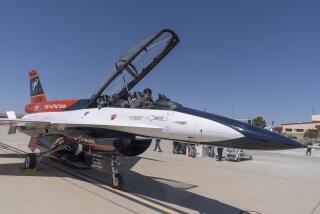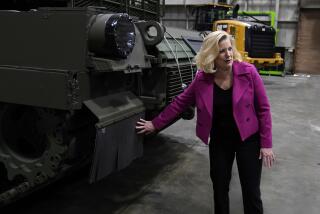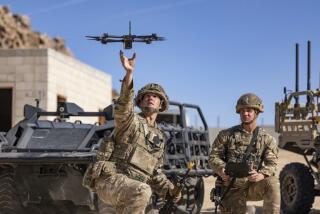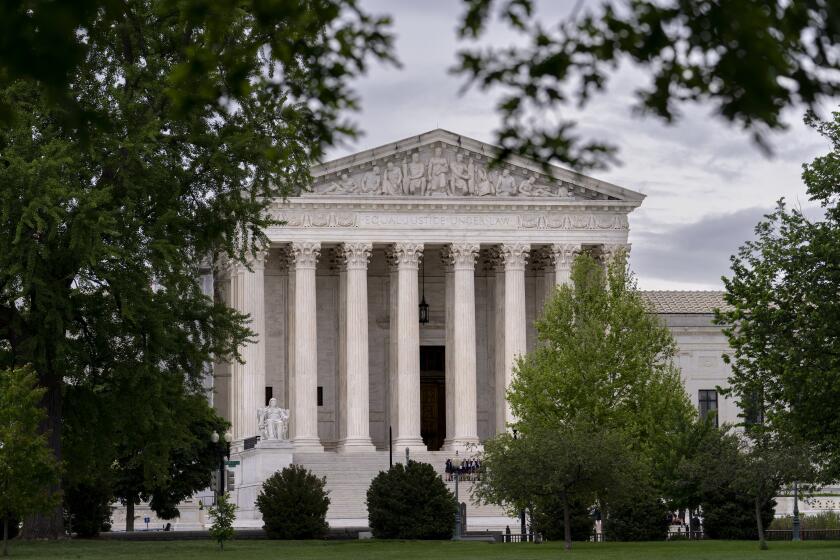Battle for Military’s Future Unresolved
- Share via
WASHINGTON — Already, the lightning success of U.S. forces in Iraq is being hailed by the Bush administration as vindication of its blueprint for transforming the American military into a leaner, lighter force.
“With less than half of the ground forces and two-thirds of the air assets used 12 years ago in Desert Storm, Secretary [Donald H.] Rumsfeld and [Gen. Tommy] Franks have achieved a far more difficult objective,” Vice President Dick Cheney exulted this week. “It’s proof positive of the success of our efforts to transform our military to meet the challenges of the 21st century.”
But although President Bush and his military commanders hold bragging rights for the war plan itself, the changes in the armed forces that Cheney speaks of began over the course of the last decade, most before Bush took office.
And many experts hope that the lessons the White House takes away from its Iraq success will include the crucial role that tanks, artillery and foot soldiers played.
How the lessons of Iraq are read is especially important because they are likely to influence impending major decisions about how to modernize the Army and other armed forces.
Although there is near-universal agreement on the need for change in the military, the war in Iraq has highlighted the uneasy relationship between the administration and some senior officers over exactly what kind of change is needed.
“No one argues with the power of precision-guided weapons, intelligence and surveillance that has again been demonstrated in Iraq,” said Byron K. Callan, a defense analyst for Merrill Lynch. “However, the extensive use of heavy ground force ... might restore some balance to defense modernization debates that were heavily tilted toward air power” and precision weaponry.
Rumsfeld is poised to make far-reaching decisions about the future shape of the military. As early as mid-May, he and his top aides are scheduled to decide whether the Army can move forward with its transformation project -- a six-year, $50-billion plan to develop new tanks and other weapons that are lighter and faster than today’s equipment but equally overwhelming on the battlefield.
Rumsfeld has not revealed how he feels about the Army’s plans, but he has emphasized lighter ground forces. And he has placed greater focus on precision missiles, intelligence, special operations and information technology.
Before the Iraq war began, for example, Rumsfeld repeatedly questioned the need for large numbers of heavy armored units and challenged military commanders to come up with plans for ground forces that were lighter and leaner.
To the extent that the administration sees its earlier position as vindicated and downplays conventional ground forces in the future, Army officials say, the military could be left wanting.
“You have to have the ability to deal with a massed, heavy force,” said Lt. Gen. John M. Riggs, chief of the Army’s transformation program. “You’ve got to be able to overpower an enemy on the ground if you want to control territory and make people bend to your will.”
Gregory Urwin, a military analyst at Temple University, agrees. “I’m not quite ready to give up on the heavy army yet,” he said. “It’s not clear how well things would have worked out without it, or who our next enemy may be.”
Besides, he added, “the Iraqi army was outclassed. We shouldn’t get too cocky about this victory.”
What is clear, experts say, is that what made U.S. forces irresistible was not any one element but the combination of air, sea and ground forces, including both heavy and light infantry.
“If there is a single thing that jumps out at you about Iraq, it is that combined arms works like gangbusters,” said Richard Hart Sinnreich, former director of the Army School of Advanced Studies. “Every time one piece of the force ran into something troublesome, another piece of the force helped out.
“Air helped ground. Ground helped air. If the right hand didn’t get them, the left hand did.”
But the key to such operations, in addition to improving communications and cooperation within and among the services, was having a balance of powerful forces of all kinds.
“Every time we try to rely on a single solution, we screw it up,” Sinnreich said, referring to overzealous advocates of air power, special operations and information warfare. “The battlefield is too complex for that. There is no silver bullet.”
For example, before U.S. troops reached Baghdad, critics of conventional forces argued that tanks and armored fighting vehicles would be of little use in urban combat. As it turned out, armor enabled infantry to penetrate deep into the city and defeat pockets of resistance with few American casualties and relatively few civilian deaths.
Artillery, which some soldiers call “dragon’s breath,” also proved highly effective, especially during bad weather that limited air support and in the later stages of the war, when U.S. and Iraqi fighters were often only a few hundred yards apart.
“Artillery is our only seven-days-a-week, 24-hour-a-day fire support system,” said Marine Capt. Joe Plenzler.
The Marines’ 155-millimeter howitzer is effective at a range of more than 15 miles. With its computerized targeting, it can hit an object the size of a 50-gallon drum. In one 30-minute barrage, 400 rounds were fired at Iraqi positions.
So many shells were in the air at once that computers and satellite imagery were used to keep projectiles from colliding.
“It’s like being an air traffic controller in Los Angeles,” said Gunnery Sgt. Will Villalobos of the 1st Marine Division.
At the same time, close support from air power played a crucial role in the ground war.
A Pentagon official who spoke on condition of anonymity said that on one day last week, a cavalry regiment trying to take a bridge from Iraqi forces called in F-15 fighters to bomb the enemy. But the F-15 pilots, flying in a blinding sandstorm, could not see well enough to strike their targets without risking hitting the U.S. troops nearby.
The pilots, on the spur of the moment, contacted an E-86 Joint Star plane flying above the sandstorm. The pilots of that plane, outfitted with radar and computer systems, located the Iraqi fighters threatening the regiment and fed their coordinates to the jets, which bombed the positions, the official said.
To be sure, advocates for heavy conventional forces acknowledge that today’s units are too heavy and too slow and consume too much fuel, ammunition and other supplies.
What comes next, according to the Army’s transformation plan, is the development of radically new weapons and combat forces by the end of this decade. They would combine the speed and agility of today’s airborne and light infantry units with the killing power and ability to withstand enemy fire that characterize today’s heavy tanks and armored fighting vehicles.
On paper at least, what the Army calls its Future Combat System, or FCS, seems to mesh closely with the leaner, faster force that Rumsfeld, Cheney and others have advocated.
The FCS would include tanks that have the battlefield capabilities of today’s 70-ton M-1A1 Abrams behemoth, but would weigh 20 tons or less.
Unlike the M-1A1, such “platforms” could be transported by air. Instead of the huge logistical trains necessary to keep them supplied, a brigade of these tanks would carry enough supplies to operate for up to a week without substantial support.
The Army promises to be able to deploy an FCS brigade anywhere in the world within 96 hours, a full division like the 3rd Infantry that led the attack on Baghdad in five days, and five divisions in 30 days.
Today, it can take several months for a division to move its heavy tanks, artillery, infantry vehicles, fuel tankers and other equipment to a potential trouble spot. Equipment is usually moved by train to shipping ports and then by surface ships overseas. Troops usually follow by air.
Future Army units could be moved entirely by air, or aboard swift transport vessels built to deliver forces quickly, under difficult conditions.
Similarly, the Army’s new forces could leapfrog across future battlefields by air to seize crucial objectives without risk of being overwhelmed by an enemy’s heavy forces. Their tanks and other equipment would be light enough to be delivered by air, but powerful enough to overtake the enemy.
Not all the technology needed for such forces exists today, but Army planners say their studies show it can be ready by the end of the decade if they are allowed to move forward.
*
Cooper reported from Washington and Pae from Los Angeles. Times staff writers Esther Schrader in Washington and Tony Perry in Iraq contributed to this report.
More to Read
Get the L.A. Times Politics newsletter
Deeply reported insights into legislation, politics and policy from Sacramento, Washington and beyond. In your inbox twice per week.
You may occasionally receive promotional content from the Los Angeles Times.










